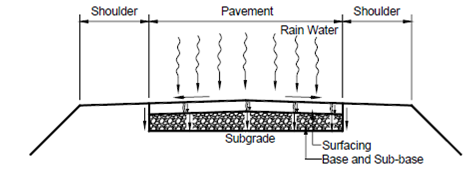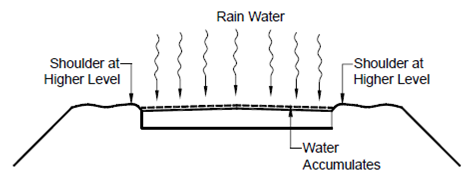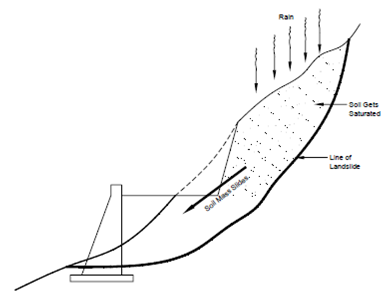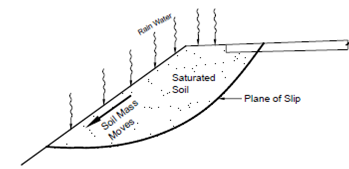Necessity for Road Drainage:
Poor drainage can cause damage to the various components of a road in the following manner:
(a) Water can enter the various pavement layers through cracks and potholes in a pavement and the pavement edges. When this water reaches the sub-grade, the soil becomes moist and saturated and loses its supporting power. As a result, the pavement sinks and settles, the cracks widen and more potholes develop (Figure 1).

Figure: Rain Water entering Sub-grade through Cracks
(b) The water reaching the sub-grade has no outlet if the material below the shoulders is not drainable. Thus a "bathtub" situation develops, with the pavement surrounded by water on all its three sides (Figure 2). This causes the pavement to sink and settle.

Figure: Pavement Surrounded by Water on all Three Sides
(c) If the earthen shoulders are not trimmed and graded regularly, the shoulders often become higher than the pavement, and the surface water cannot get drained. The water accumulates on the road, gets into the pavement layers and damages the road (Figure 3).

Figure: Higher Shoulders Result in Accumulation of Rain Water
(d) In hill roads, landslides are often caused by lack of drainage in the hill slopes (Figure).

Figure : Landslide Caused by Lack of Drainage in Hill Roads
(e) Water can travel upwards due to capillary rise in a clayey soil sub-grade, saturate the pavement supporting layer and decrease its bearing power. As a result, the pavement sinks and settles (Figure 5).

Figure : Capillary Rise of Water Causes Saturation and Softening of Pavement Support
(f) In high embankments, the water entering the soil increases its weight and reduces its shear strength, thus causing slips (Figure 6).

Figure : Slip Caused in Embankment Slope due to Lack of Drainage